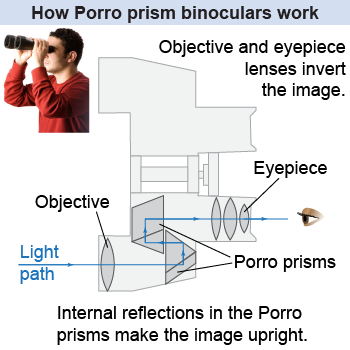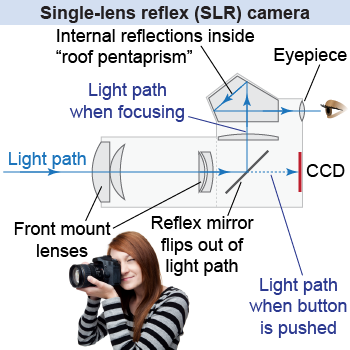|
 Galileo’s contemporaries immediately began using his telescope for military purposes, e.g., in order to see enemy troop positions and ships. Today people will instead use binoculars for field work. If binoculars only used objective and eyepiece lenses, then they would produce inverted images, just as Galileo’s telescope did. Porro prism binoculars, however, deliver an upright image by passing the light through internal reflections in two prisms. One prism reflects the light twice horizontally, while the other reflects the light twice vertically. Binoculars are also popular with amateur astronomers because they are easy to use and can image a wide field.
Galileo’s contemporaries immediately began using his telescope for military purposes, e.g., in order to see enemy troop positions and ships. Today people will instead use binoculars for field work. If binoculars only used objective and eyepiece lenses, then they would produce inverted images, just as Galileo’s telescope did. Porro prism binoculars, however, deliver an upright image by passing the light through internal reflections in two prisms. One prism reflects the light twice horizontally, while the other reflects the light twice vertically. Binoculars are also popular with amateur astronomers because they are easy to use and can image a wide field. 
|
 The compound microscope uses the same principles as the refracting telescope: An objective lens forms an image of the sample, and the eyepiece lens uses that image as its object to form a magnified image of the sample. A prism is often used to create two internal reflections to divert the light to a comfortable viewing angle. Most microscopes have a lamp under the sample to illuminate it. Typical microscopes can achieve magnifications of 50× or more.
The compound microscope uses the same principles as the refracting telescope: An objective lens forms an image of the sample, and the eyepiece lens uses that image as its object to form a magnified image of the sample. A prism is often used to create two internal reflections to divert the light to a comfortable viewing angle. Most microscopes have a lamp under the sample to illuminate it. Typical microscopes can achieve magnifications of 50× or more. 
|
 Both digital and film cameras use multiple lenses to focus the light into an image. The magnification of the camera can be changed by moving the position of the front mount lenses. Older cameras recorded images onto photographic film, but digital cameras use a CCD as a detector. Professional photographers mostly use the single-lens reflex (SLR) camera, which allows them to see the image directly through the lens—not through an electronic finder screen. The reflex mirror is mounted at a 45° angle to the incoming light and diverts the light to the eyepiece. The problem with using only a reflex mirror is that the camera’s lenses invert the image. So the light passes through internal reflections in a roof pentaprism, which make the image upright again. When the photographer pushes the button to take a picture, the reflex mirror flips out of the way briefly to allow light to reach the detector.
Both digital and film cameras use multiple lenses to focus the light into an image. The magnification of the camera can be changed by moving the position of the front mount lenses. Older cameras recorded images onto photographic film, but digital cameras use a CCD as a detector. Professional photographers mostly use the single-lens reflex (SLR) camera, which allows them to see the image directly through the lens—not through an electronic finder screen. The reflex mirror is mounted at a 45° angle to the incoming light and diverts the light to the eyepiece. The problem with using only a reflex mirror is that the camera’s lenses invert the image. So the light passes through internal reflections in a roof pentaprism, which make the image upright again. When the photographer pushes the button to take a picture, the reflex mirror flips out of the way briefly to allow light to reach the detector. 
|
Why do prism binoculars deliver an upright image whereas a compound microscope delivers an inverted image?
 |
Prism binoculars use two sets of internal reflections to convert the image from inverted to upright. The compound microscope has only one set of internal reflections, so it cannot convert the image to be upright. 
|
| |
|

